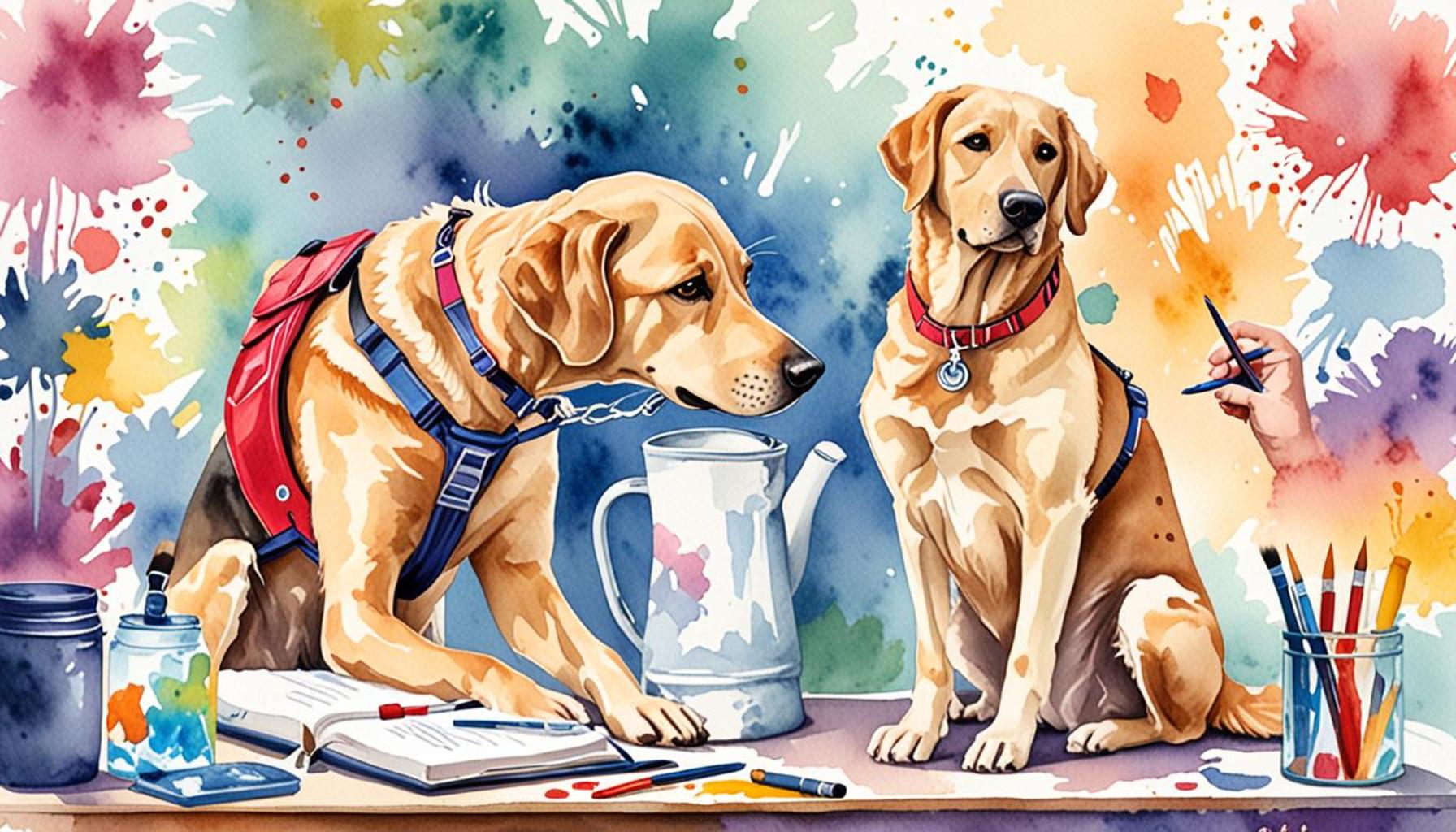Service Dog Training: Preparation and Essential Skills for Assistance

Understanding the Importance of Service Dog Training
For individuals with disabilities, service dogs are transformative companions, offering not just physical assistance but emotional support, companionship, and enhanced security during daily activities. These specially trained animals can mitigate difficulties faced by their handlers, providing independence and improving quality of life. However, the journey to producing a reliable service dog begins with comprehensive training that is not to be taken lightly.
The training that service dogs undergo goes beyond simple commands; it involves a variety of skills designed to prepare these animals for a multitude of real-world scenarios that they may encounter. Here are some essential aspects of this extensive training process:
- Foundation Training: This crucial stage covers basic obedience commands, such as sit, stay, and come. These commands form the bedrock of all further training, ensuring that the dog is well-behaved and responsive to its handler’s commands in everyday situations.
- Socialization: Proper socialization is vital for service dogs; it involves exposing them to diverse environments—including crowded spaces like malls or public transport—and varied situations, which might include loud noises or bustling crowds. This ensures that the dog remains calm and focused when accompanying their handler in public settings.
- Task-Specific Skills: Specialized training is tailored to address the unique needs of the handler. For example, a service dog could be trained to retrieve medication for a person with a chronic illness, assist individuals with mobility issues by providing balance, or guide visually impaired individuals through complex routes.
In addition to these core skills, the emotional bond that forms between the handler and the service dog is equally essential. This deep connection fosters mutual understanding, allowing the dog to respond intuitively to the handler’s physical and emotional needs. Establishing this bond can enhance the effectiveness of the service dog’s tasks and creates a more harmonious dynamic.
The training process is often a collaborative effort involving professional trainers, handlers, and sometimes even family members. Moreover, it’s important to acknowledge that the training process can be complex and time-consuming, requiring dedication and patience from everyone involved to successfully shape a standard dog into a dedicated assistance companion.
In the following sections, we will explore the detailed steps required for service dog training and delve into the specific skills that enable these canines to make significant differences in the lives of those they serve. Together, we will uncover how service dogs not only change lives but also redefine independence and empowerment for many individuals across the United States.

DIVE DEEPER: Click here to discover the benefits of pet adoption for children
The Preparation Process: Laying the Groundwork for Success
Proper service dog training begins long before a dog is paired with its handler. The preparation phase is crucial, as it sets the stage for the skills that will be developed later. A successful training program requires a thoughtful approach and a thorough understanding of the individual needs of both the dog and the handler. Here are some key components that can significantly enhance the training process:
- Assessment of Temperament: Not every dog is suited for service work. Before embarking on the training journey, potential service dogs should undergo a temperament assessment that evaluates their behavior, trainability, and social skills. Ideal candidates are typically confident, focused, and calm, possessing the right temperament to handle the stresses of service tasks.
- Age and Health Considerations: The age and health of a dog can greatly influence its ability to perform as a service animal. Generally, service dog candidates are chosen from breeds known for their intelligence and reliability, often starting their training as puppies around six months to one year old. Additionally, ensuring the dog is healthy and up-to-date on vaccinations is essential for a successful training period.
- Handler Engagement: The involvement of the handler in the training process is vital. They should actively participate, which helps establish a strong bond between the dog and its owner. This engagement also enables the handler to understand the training methods and commands that the dog is learning, fostering a sense of teamwork and mutual respect.
- Setting Training Goals: Defining clear and achievable goals at the outset can enhance both the success of the dog and the handler’s satisfaction. Each handler’s needs can differ widely; for example, a person with a physical disability may require different assistance than someone dealing with a medical condition, such as PTSD. Establishing these goals allows trainers to tailor the education process accordingly.
Once proper preparation is in place, the next phase is to embark on the training itself, which consists of essential skill development intertwined with ongoing socialization. Each of these components is indispensable in crafting a reliable and effective service dog that meets specific assistance needs.
Through consistent practice, patience, and commitment, both the dog and handler can cultivate a partnership that enhances the individual’s ability to navigate daily life. As we delve deeper into the next sections, we will explore the essential skills that service dogs must acquire, enabling them to provide the much-needed support and independence their handlers rely on.
| Training Categories | Key Advantages |
|---|---|
| Basic Obedience | Establishes a foundation for communication and control between the handler and dog. |
| Task Training | Equips dogs with the skills to perform specific tasks such as retrieving medication or guiding individuals with visual impairments. |
| Socialization | Helps dogs to be comfortable in various environments, reducing anxiety and improving reliability. |
| Public Access Training | Ensures the dog behaves appropriately in public spaces, increasing accessibility for the handler. |
Service dog training is imperative for those who rely on assistance in daily life. The preparation for such a commitment involves understanding the essential skills required for effective assistance. From mastering basic commands to performing specific tasks like alerting to medical issues, every phase of training has unique benefits that significantly enhance the dog’s capability to serve. Additionally, socialization is critical; dogs that interact with various environments are more adaptable and reliable. Moreover, ensuring good behavior during public access not only builds trust but also fosters inclusivity. Each training category reveals layers of skills that culminate in a proficient service dog, ready to provide invaluable support to its handler. The journey of service dog training unfolds numerous opportunities, encouraging deeper exploration into the methods and practices that yield the best outcomes.
DON’T MISS: Click here to learn more
Essential Skills for Service Dogs: The Heart of Assistance
Once adequate preparation is in place, the training of a service dog accelerates to the acquisition of essential skills tailored to meet the specific needs of their handlers. This is a critical phase, as these skills allow the dogs to provide meaningful assistance that enhances their handlers’ quality of life. Below is an overview of the fundamental skills service dogs must master during their training:
- Basic Obedience Commands: Before delving into specialized tasks, service dogs must have solid foundational skills such as sit, stay, come, and heel. These commands establish the groundwork for good manners and obedience, ensuring the dog can follow instructions accurately and respond positively to their handler.
- Task-Specific Skills: Each service dog is trained to perform specific functions that cater to their handler’s needs. For instance, a service dog assisting someone with mobility issues may learn to fetch items, guide their handler around obstacles, or retrieve a dropped phone. In contrast, those aiding individuals with PTSD might be taught to apply pressure during panic attacks or navigate crowded environments safely. These task-specific skills are the core of a service dog’s functionality and must be meticulously practiced and reinforced throughout their training.
- Socialization: A well-rounded service dog must be socialized to various environments, sounds, and situations. This aspect of training is essential to prepare the dog for real-world scenarios where they will encounter unfamiliar people, pets, and potentially stressful environments. Regular exposure to different settings—such as shopping malls, public transportation, and parks—helps minimize anxiety and ensures that the dog can perform its duties regardless of distractions.
- Public Access Training: Given that service dogs accompany their handlers in public spaces, public access training is paramount. This component of their training focuses on ensuring appropriate behavior in settings like restaurants, stores, and hospitals. Service dogs must learn to remain calm, quiet, and focused during outings, reinforcing their role as reliable assistance animals. Proper public access training also educates handlers on their rights and responsibilities under the Americans with Disabilities Act (ADA).
Training must also involve positive reinforcement techniques, which include rewarding the dog for desired behaviors. This approach relies on praising, treating, or otherwise incentivizing the dog each time they successfully complete a task, fostering a strong bond and promoting self-confidence in the animal. Training sessions should be kept short but frequent, allowing the dog to engage without becoming overwhelmed.
Moreover, it is essential to highlight that training is not a one-time event but an ongoing process. Regular refreshers and continued practice of both new and previously learned skills contribute to long-lasting effectiveness. Handlers should also become advocates for their service dogs, understanding the nuances of their assistance tasks, and offering timely reinforcement, adjustments, and encouragement as necessary.
With dedication, consistency, and love, the partnership between the service dog and the handler flourishes through this phase, effectively paving the way for a seamless bond that supports a vibrant, independent life for the individual in need. As the training progresses and both parties become more adept, the focus shifts toward the nuanced tasks that will ultimately define the unique relationship and assistive capabilities the service dog will provide.
DISCOVER MORE: Click here to learn about the benefits of natural feeding for pets
Conclusion
In conclusion, the journey of service dog training is a transformative process that not only equips these remarkable animals with essential skills but also forges an unbreakable bond between the dog and their handler. The comprehensive preparation and focus on foundational skills, socialization, and public access training create a solid framework that enables service dogs to fulfill their vital roles in society. Each task-specific skill, whether it’s retrieving an item, calming an anxious handler, or navigating obstacles, exemplifies the profound impact that a well-trained service dog can have on enhancing the quality of life for individuals with disabilities.
The commitment to ongoing training, marked by positive reinforcement and consistent practice, underscores that the relationship with a service dog is a lifelong partnership that evolves over time. As handlers immerse themselves in understanding and advocating for their assistance animals, they foster an environment where their dogs can thrive, ensuring the dog remains effective in fulfilling their critical duties.
As we recognize the significance of service dogs in promoting independence and inclusion, it becomes essential to support access to proper training resources and to raise awareness of the rights afforded to service dog teams under the Americans with Disabilities Act (ADA). By championing effective training practices, we can contribute to a society that values the extraordinary roles these animals play, ultimately leading to enriched lives for all involved. With dedication and love, the synergistic partnership between service dogs and their handlers serves as a testament to the remarkable ways in which we can uplift and empower each other.



